Top Drones in Commercial Use for 2025: Enhance Your Business
- Nickolas Williams

- May 2
- 17 min read
Taking Flight: The Best Commercial Drones of 2025
Need to optimize inspections, capture stunning aerial footage, or enhance surveying workflows? This list showcases the top 8 drones in commercial use for 2025. We'll cover key features and pros/cons of top contenders like the DJI Mavic 3 Enterprise, Skydio X10, and Autel EVO II Enterprise, along with heavy-lift platforms like the DJI Matrice 300 RTK and Wingtra One. Find the perfect drone for your commercial needs, whether it's precision mapping with the senseFly eBee X, security with the Parrot ANAFI USA, or cinematography with the FreeFly Astro.
1. DJI Mavic 3 Enterprise
The DJI Mavic 3 Enterprise stands out as a leading choice for commercial drone applications, offering a powerful blend of advanced features, portability, and robust performance. This professional-grade foldable drone is engineered for diverse commercial operations, from infrastructure inspection and mapping to public safety and search and rescue. Its dual-camera system sets it apart, featuring a 4/3 CMOS Hasselblad camera for stunning 20MP photos and 5.1K video, complemented by a 12MP telephoto camera with a remarkable 28x hybrid zoom. This combination empowers users to capture highly detailed imagery from a safe distance, crucial for tasks such as assessing structural damage or monitoring wildlife. With a maximum flight time of 45 minutes, the Mavic 3 Enterprise allows for extended operational periods, minimizing downtime and maximizing efficiency. Furthermore, omnidirectional obstacle sensing ensures safe navigation in complex environments, a critical factor for commercial operations often conducted in challenging airspace.
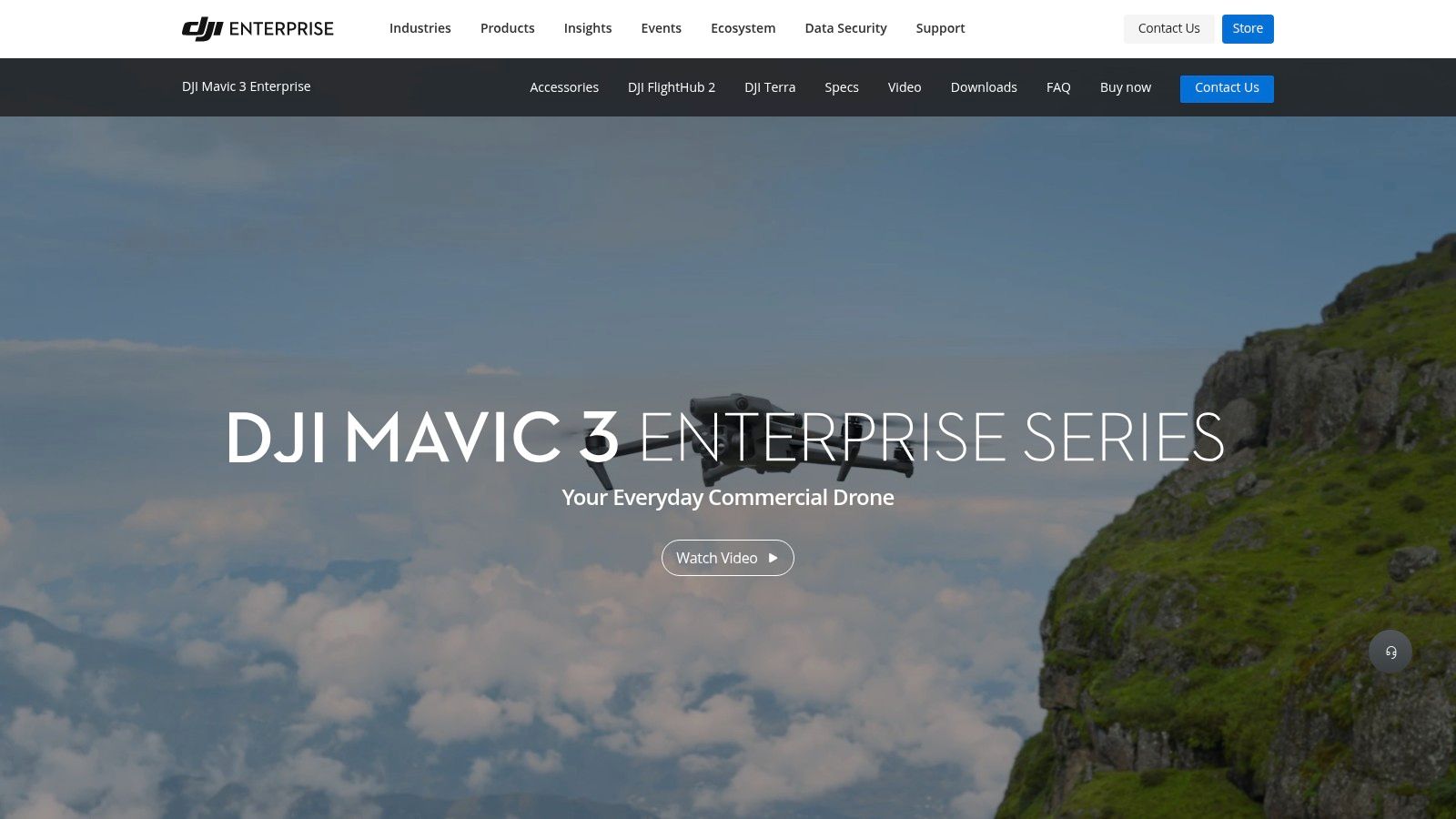
The inclusion of an RTK module provides centimeter-level positioning accuracy, essential for precise mapping and surveying tasks. This level of accuracy makes the Mavic 3 Enterprise a valuable tool for applications like creating accurate 3D models of construction sites or generating precise agricultural maps for targeted crop management. Additional features such as a built-in loudspeaker and beacon light further enhance its utility in public safety and search and rescue scenarios. For instance, the loudspeaker can be used to communicate with individuals on the ground during emergency situations, while the beacon enhances visibility during low-light operations.
Compared to other commercial drones in its class, the Mavic 3 Enterprise offers a compelling balance of image quality, flight time, and advanced features. While some competitors might offer slightly longer flight times or specialized payloads, the Mavic 3 Enterprise excels in its versatility and overall performance. However, the high price point (approximately $6,500 for the complete Enterprise package) can be a barrier to entry for some. Additionally, mastering the advanced features requires a significant learning curve, and users should anticipate dedicating time to training and practice. Finally, depending on the specific commercial operations, additional licensing or certifications might be required, adding to the overall cost and complexity.
Setting up the Mavic 3 Enterprise is relatively straightforward, thanks to DJI's user-friendly software and intuitive controls. However, it's crucial to carefully calibrate the drone and its sensors before each flight to ensure optimal performance and safety. For those new to commercial drone operations, exploring resources like the Learn more about DJI Mavic 3 Enterprise can provide valuable insights and guidance.
Its exceptional image quality, extended flight time, and comprehensive safety features make the DJI Mavic 3 Enterprise a top contender for professionals seeking a reliable and powerful drone for a wide range of commercial applications. While the price tag might be substantial, its capabilities and performance justify the investment for serious commercial drone operators seeking a versatile and high-performing platform. This drone earns its spot on this list due to its comprehensive suite of features specifically designed for drones in commercial use.
2. Skydio X10
The Skydio X10 secures its spot on this list of top drones in commercial use thanks to its unparalleled autonomous flight capabilities and robust security features. This American-made drone is purpose-built for enterprise applications where reliability, data security, and advanced autonomous features are paramount. While other drones might offer broader consumer appeal, the X10 targets specific niches within the commercial drone landscape, excelling where others fall short.
This drone is more than just a flying camera; it's an intelligent aerial platform. Its 50MP primary camera, with optional 4K thermal imaging payloads, captures high-quality visual and thermal data, making it ideal for a range of commercial operations. Think infrastructure inspection—easily identifying structural weaknesses on bridges or power lines. Consider public safety—tracking suspects or monitoring disaster zones with unmatched precision and safety. These are just a few examples where the X10 shines.
The X10’s industry-leading autonomous navigation and obstacle avoidance, powered by advanced AI, sets it apart in the crowded drone market. This isn't just about avoiding trees; it's about navigating complex environments like dense forests, industrial sites, or disaster zones where manual piloting would be risky or impossible. This level of autonomy frees up the operator to focus on the task at hand, whether that’s analyzing the incoming data or coordinating ground crews.
Key Features and Benefits:
50MP Primary Camera with Interchangeable Payloads: Capture stunningly detailed visual data and switch to thermal imaging for specialized applications. This flexibility makes the X10 adaptable to a variety of commercial uses.
Industry-Leading Autonomous Navigation and Obstacle Avoidance: Navigate complex environments safely and efficiently, allowing operators to focus on data collection and analysis. This feature is a game-changer for infrastructure inspection and search and rescue operations.
Encrypted Data Transmission and Storage: Ensures data security, a crucial requirement for sensitive government applications and critical infrastructure inspections. This built-in security provides peace of mind for organizations handling confidential information.
35-Minute Flight Time: Conduct longer missions without needing frequent battery swaps, maximizing operational efficiency. This extended flight time reduces downtime and improves overall productivity.
Made in USA with Enterprise-Grade Security Features: Provides a level of trust and security often required by government agencies and critical infrastructure operators. US-based manufacturing and support also offer a distinct advantage for certain clients.
Pros:
Unmatched autonomous flight capabilities.
Superior obstacle avoidance in complex environments.
Trusted for sensitive government applications.
US-based manufacturing and support.
Cons:
Premium pricing (starting at approximately $7,000). This significant investment makes it more suitable for organizations with specific budgetary allocations for advanced drone technology.
More limited global support network compared to industry giants like DJI. This might be a consideration for international operations.
Specialized software ecosystem. While powerful, the Skydio software requires specific training and integration.
Implementation and Setup Tips:
While highly autonomous, proper training is essential to maximize the X10's capabilities. Familiarize yourself with the Skydio software ecosystem and flight planning tools. Pre-flight checks are crucial, especially for commercial operations. Ensure proper calibration and payload selection before each flight. Consider contacting Skydio directly for specialized training and onboarding support.
Comparison:
Compared to more consumer-focused drones like those from DJI, the Skydio X10 prioritizes autonomous flight and data security over broader feature sets and affordability. This makes it a specialized tool specifically designed for demanding commercial applications where these features are crucial.
Website: https://www.skydio.com/skydio-x10
The Skydio X10 represents a significant advancement in commercial drone technology. Its focus on autonomous operations and robust security makes it a valuable asset for businesses and government agencies operating in demanding environments. While the premium price tag might be a barrier for some, the X10 delivers exceptional value for those who require its unique capabilities within the spectrum of drones in commercial use.
3. Autel EVO II Enterprise
The Autel EVO II Enterprise is a powerful and versatile platform ideal for a range of commercial drone applications. Whether you're conducting detailed inspections, performing search and rescue operations, or creating high-resolution maps, the EVO II Enterprise offers a compelling blend of performance and adaptability. Its modular design allows for quick swapping of payloads, making it a highly adaptable tool for professionals. This makes it a significant contender in the market for drones in commercial use.
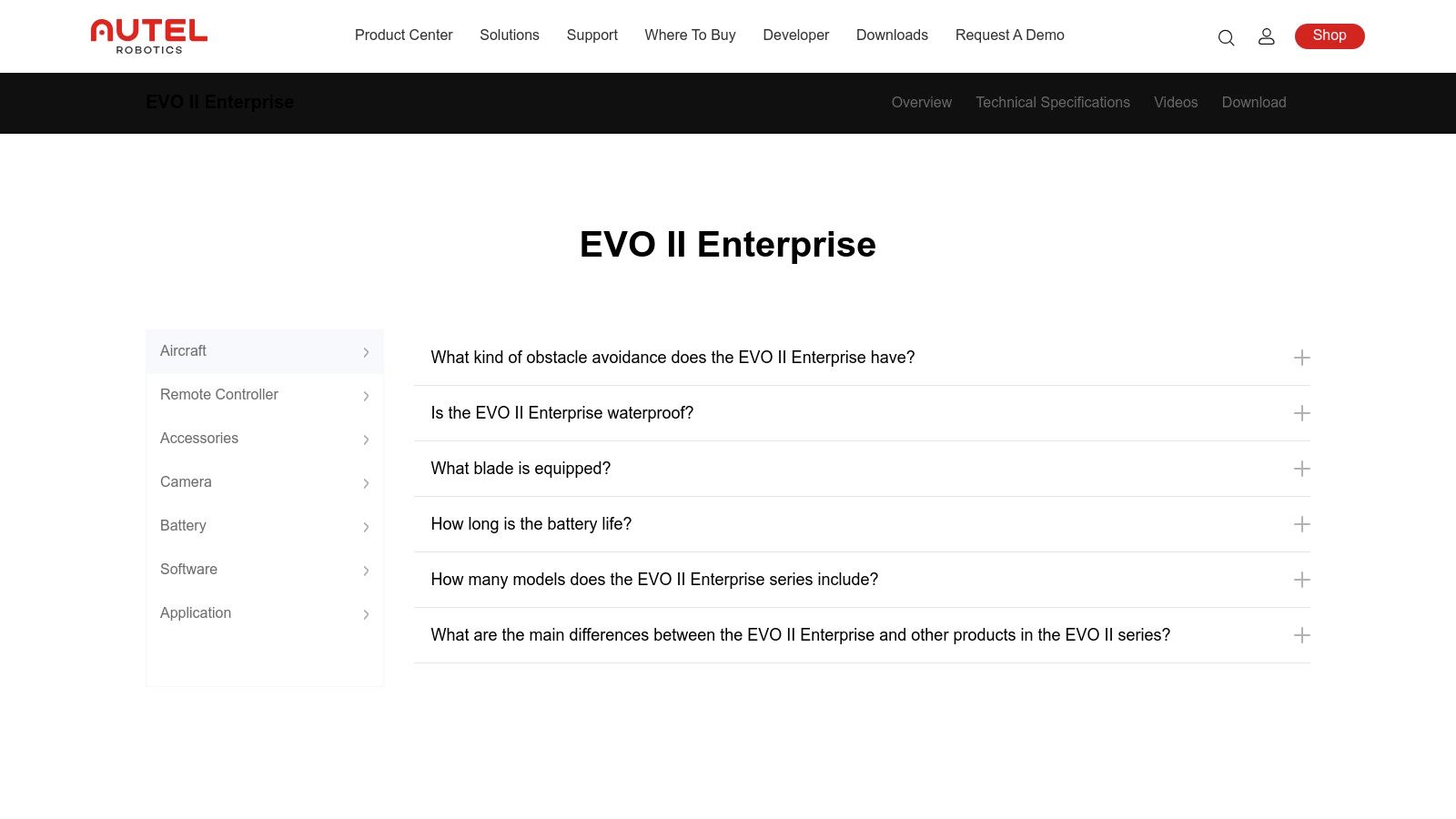
The EVO II Enterprise stands out with its 8K video capability captured by a 48MP camera, providing incredibly detailed imagery. This high-resolution imaging is invaluable for infrastructure inspections, allowing operators to identify minute cracks or defects that might be missed with lower-resolution cameras. The available configurations cater to specific needs, with options for visual, thermal, and Real-Time Kinematic (RTK) modules. For example, the thermal variant is particularly useful for search and rescue, firefighting, and agricultural applications, while the RTK module provides centimeter-level accuracy for surveying and mapping. A 40-minute flight time ensures ample coverage for larger areas, minimizing downtime and maximizing efficiency. Furthermore, the 360° obstacle avoidance system significantly enhances safety during flight operations, reducing the risk of collisions in complex environments. The IP43 weather resistance rating provides additional protection against light rain and dust, expanding the operational window in challenging conditions.
A key advantage of the Autel EVO II Enterprise is its position as a strong alternative to DJI for security-conscious organizations. With increasing concerns about data security and government regulations surrounding Chinese-manufactured drones, the Autel EVO II Enterprise provides a compelling option that meets various security requirements. This makes it a particularly attractive choice for government agencies, law enforcement, and critical infrastructure operators.
While pricing varies depending on configuration, the EVO II Enterprise offers a good value proposition considering its advanced features and capabilities. (Contact Autel Robotics or an authorized dealer for specific pricing details.) Technical requirements include a compatible mobile device to run the Autel Explorer app for flight control and data management. Setup involves charging the drone and remote controller, installing the app, and calibrating the drone before its first flight. Familiarizing yourself with the software and flight controls is essential for safe and efficient operation.
Compared to market leaders like DJI, the Autel EVO II Enterprise does have a less developed software ecosystem and a smaller customer support network. Additionally, it is slightly heavier than some competing models. However, its robust features, competitive pricing, and focus on security make it a worthy contender in the commercial drone space.
Pros:
Excellent alternative to DJI for security-conscious organizations
High-resolution imaging capabilities (8K video, 48MP camera)
Modular design allows for payload switching
Good value proposition for features offered
40-minute flight time and 360° obstacle avoidance
Cons:
Software ecosystem less developed than market leaders
Customer support network not as extensive
Heavier than some competing models
4. DJI Matrice 300 RTK
The DJI Matrice 300 RTK stands out as a leading choice among drones in commercial use, earning its spot on this list for its exceptional performance, durability, and advanced features tailored for demanding industrial applications. This isn't your average recreational drone; the M300 RTK is a powerful workhorse built for complex operations like infrastructure inspections, surveying, search and rescue, and precision agriculture.
This drone is a significant investment, starting at approximately $13,000 without payloads. The final price tag will climb considerably depending on the chosen camera system and accessories. While other drones might offer lower entry points, the M300 RTK justifies its cost with unparalleled reliability and capability.
Its robust design boasts an IP45 rating, meaning it can handle challenging weather conditions, including dust and light rain. This durability translates to minimized downtime and consistent performance in demanding environments. Learn more about DJI Matrice 300 RTK for further details on its capabilities in various scenarios.
One of the key advantages of the M300 RTK is its impressive 55-minute maximum flight time. This extended flight endurance allows commercial operators to cover larger areas and complete more complex missions on a single battery charge, significantly improving efficiency. Furthermore, the drone's multiple payload capacity (up to 2.7kg) provides flexibility for carrying specialized cameras and sensors simultaneously. For example, you could equip the M300 RTK with both a high-resolution visual camera and a thermal camera for infrastructure inspections, gathering comprehensive data in a single flight. The advanced AI capabilities available through payloads like the H20T camera series unlock functionalities such as smart tracking, object recognition, and high-accuracy measurements, pushing the boundaries of what's possible with drones in commercial use. RTK positioning provides centimeter-level accuracy, crucial for surveying and mapping applications.
Features:
55-minute maximum flight time
Multiple payload capacity (up to 2.7kg)
IP45 weather resistance rating
RTK positioning for centimeter-level accuracy
Advanced AI capabilities with H20T and other specialized cameras
Six-directional sensing and positioning system
AirSense (ADS-B receiver) for enhanced airspace awareness
Pros:
Exceptional durability and reliability in harsh conditions
Industry-leading flight time for complex missions
Highly adaptable for various specialized payloads
Comprehensive enterprise support ecosystem
Cons:
Very high cost (approximately $13,000+ with payloads)
Large size limits portability
Complex operation requires specialized training
Implementation and Setup Tips:
Training is essential: Due to the complexity of the M300 RTK, comprehensive training is highly recommended to ensure safe and effective operation.
Payload Selection: Carefully consider your specific needs and choose the appropriate payloads to maximize the drone's capabilities.
Maintenance: Regular maintenance is vital to ensure long-term reliability and performance.
The DJI Matrice 300 RTK represents a significant investment, but its capabilities and robust design make it a valuable asset for commercial drone operators. Its extended flight time, payload flexibility, advanced safety features, and adaptability to diverse industrial applications solidifies its place as a top contender in the commercial drone space. For more information, visit the official product page: https://enterprise.dji.com/matrice-300-rtk
5. Wingtra One
The Wingtra One stands out as a premier choice among drones in commercial use, particularly for large-scale mapping and surveying applications. Its hybrid VTOL (vertical take-off and landing) fixed-wing design offers a unique advantage. Unlike traditional quadcopters limited by battery life and range, the Wingtra One takes off vertically, transitions to efficient fixed-wing flight, and then lands vertically again. This allows it to cover extensive areas, up to 400 hectares (almost 1000 acres) in a single flight, making it significantly more efficient for large projects. This capability bridges the gap between the ease of use of multirotor drones and the endurance of traditional fixed-wing aircraft. Equipped with a high-resolution 42MP Sony RX1R II camera and PPK (Post-Processed Kinematics), it delivers survey-grade accuracy, essential for professional mapping and data acquisition.
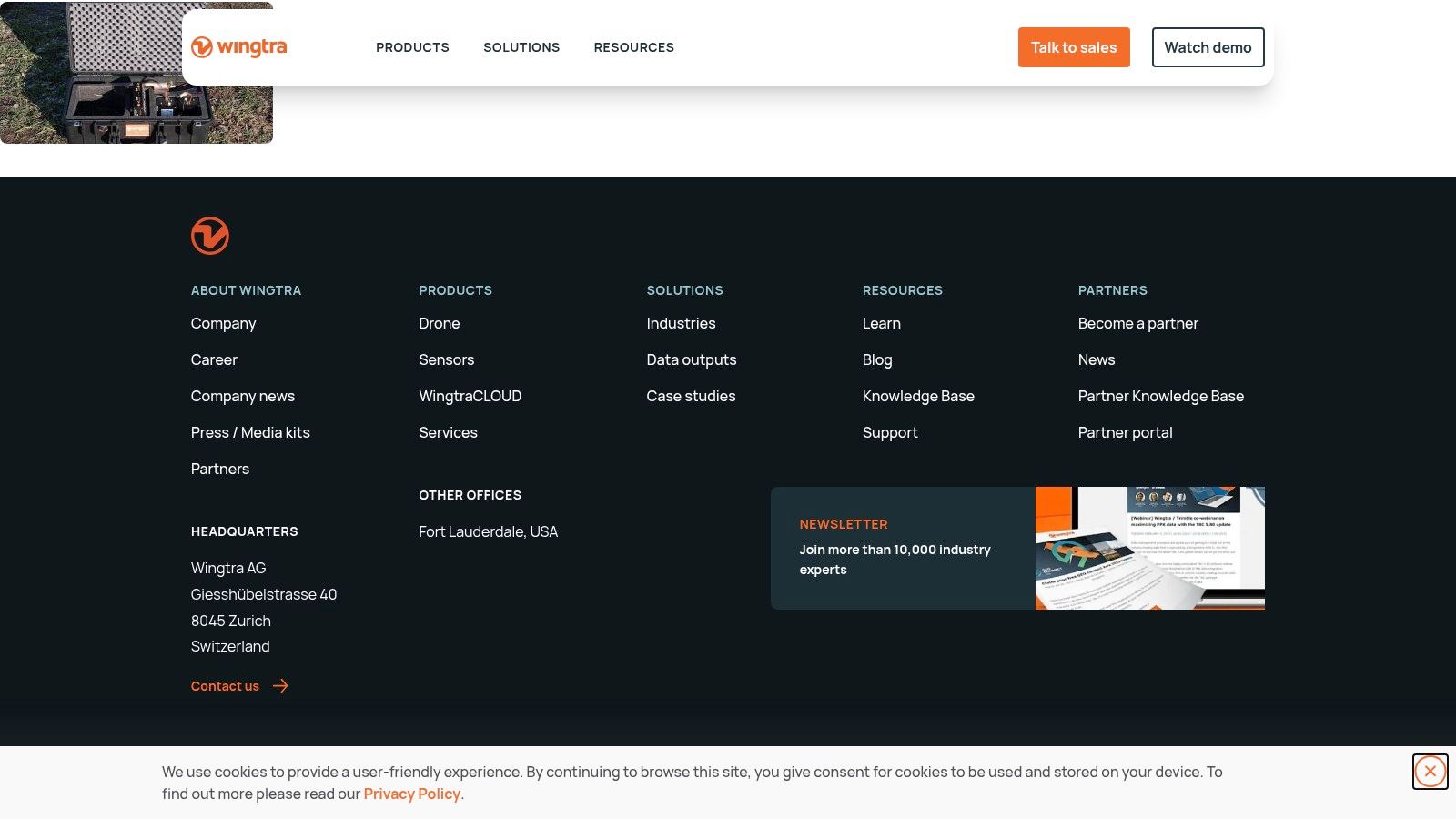
The Wingtra One finds its niche in industries demanding extensive and precise aerial surveys. In mining, it can efficiently map vast open-pit mines, monitor stockpiles, and assist in geological surveys. For agricultural applications, the drone facilitates precision farming by creating detailed maps for crop health analysis, irrigation planning, and yield prediction. Large construction projects benefit from its ability to generate accurate topographical maps, monitor progress, and survey large infrastructure developments. While quadcopters might be suitable for smaller, localized surveys, the Wingtra One’s extended range and endurance make it the preferred choice for projects covering significant areas.
Fully automated mission planning further streamlines the workflow. Users can pre-program flight paths and data acquisition parameters, simplifying operations and reducing manual intervention. PPK/RTK capabilities ensure centimeter-level accuracy, providing highly reliable data for professional applications. While the Wingtra One excels in large-scale mapping, its fixed-wing design makes it less agile than multirotor drones for close-up inspection tasks. The premium price point of approximately $25,000 (with PPK) also positions it as a tool for serious commercial operators. Additionally, its larger takeoff/landing area requirement necessitates more open space compared to compact quadcopters.
Features:
VTOL capabilities (vertical takeoff, fixed-wing flight)
Up to 59-minute flight time
42MP Sony RX1R II camera
PPK/RTK capabilities
Fully automated mission planning
Pros:
Covers vastly more area than quadcopters
High-precision mapping capabilities
Efficient workflow for large-scale surveys
Reliable in various wind conditions
Cons:
Premium price point (approximately $25,000 with PPK)
Requires larger takeoff/landing area than quadcopters
Less versatile for inspection tasks than multirotors
Website: https://wingtra.com/wingtraone/
The Wingtra One earns its spot on this list of drones in commercial use due to its unique combination of long-range, high-resolution mapping, and vertical takeoff/landing convenience. It offers a powerful solution for professionals in mining, agriculture, construction, and other industries requiring efficient and accurate large-scale aerial surveys.
6. senseFly eBee X
The senseFly eBee X stands out as a premier fixed-wing drone meticulously engineered for demanding commercial applications, solidifying its position as an industry leader, particularly within the realm of precision agriculture. This drone excels in large-scale mapping and surveying tasks for various sectors, including environmental monitoring and construction, making it a significant player among drones in commercial use. Its lightweight yet robust foam construction, weighing under 2kg, contributes to an impressive flight time of up to 90 minutes with the Endurance extension, enabling coverage of over 500 hectares in a single flight. This extensive coverage makes it exceptionally efficient for surveying vast agricultural lands, monitoring sprawling environmental sites, or mapping large construction zones.
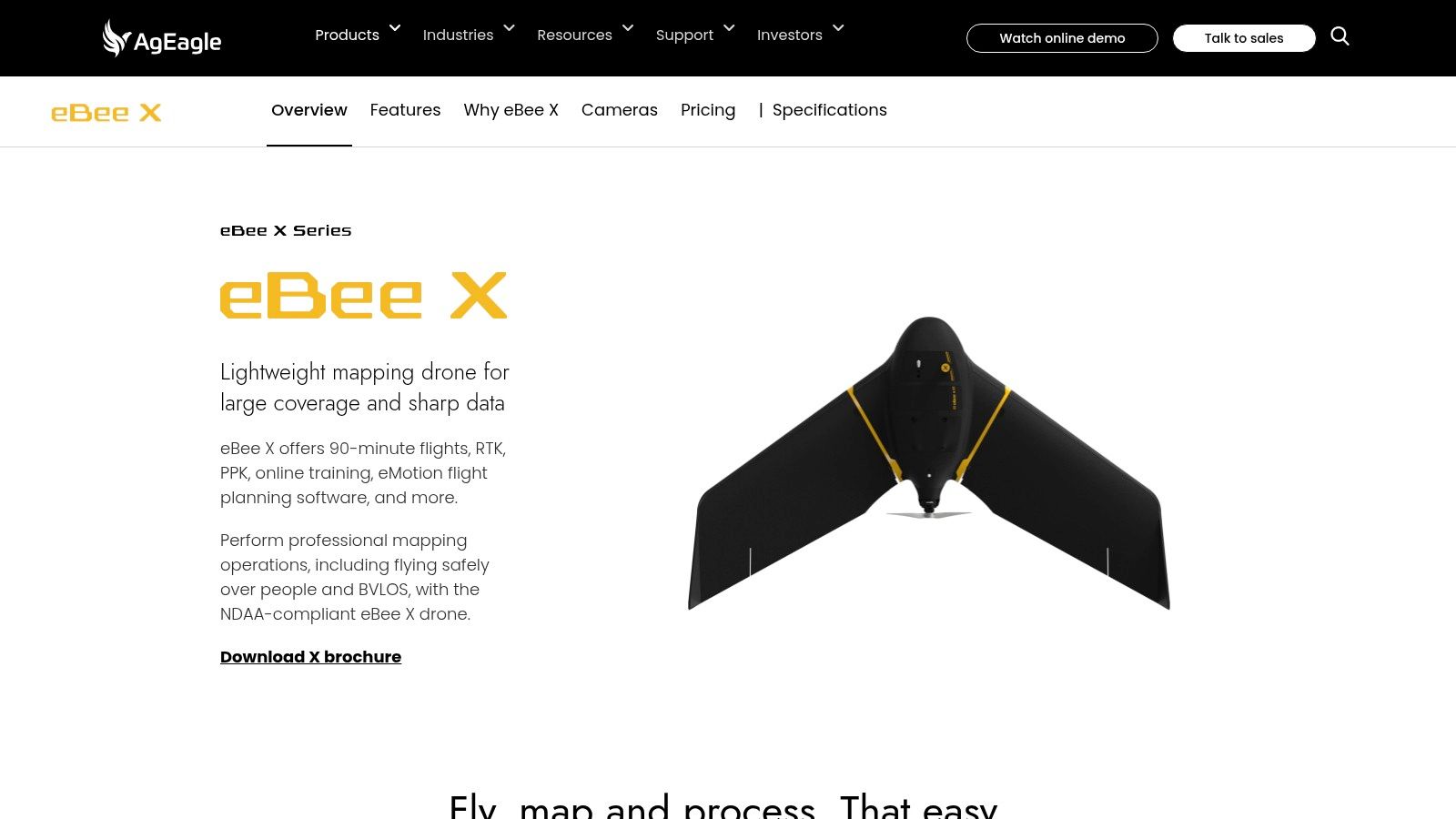
The eBee X’s compatibility with an array of specialized cameras, including RGB, multispectral, and thermal options, further enhances its versatility. For precision agriculture, multispectral imagery provides crucial data on crop health, allowing farmers to optimize irrigation and fertilization. In environmental monitoring, thermal cameras can identify heat signatures, aiding in wildlife tracking and detecting potential hazards. Its RTK/PPK capabilities ensure survey-grade accuracy, delivering highly precise geospatial data suitable for professional mapping and surveying projects. Automated flight planning and execution simplify operations, reducing the complexity of mission setup and execution. This ease of use makes the eBee X accessible to a broader range of users, even those with limited drone piloting experience.
While pricing information is not readily available and may vary depending on configuration and regional distributors, Learn more about senseFly eBee X to potentially find resources related to pricing and local availability. The eBee X's lightweight design offers a significant regulatory advantage, as it often falls under less restrictive drone categories in many regions, simplifying the process of obtaining necessary permits and approvals. This is a major benefit for commercial operators looking to streamline their operations and avoid complex regulatory hurdles. The simple launch and landing requirements further contribute to the drone's user-friendliness.
Compared to multirotor drones, the eBee X sacrifices some maneuverability in tight spaces and close-proximity inspections. Its fixed-wing design also makes it more susceptible to wind conditions compared to heavier drones. Operation requires more open space for take-off and landing, a factor to consider when planning missions. However, these drawbacks are often outweighed by the eBee X’s exceptional flight time, extensive coverage capabilities, and the regulatory advantages stemming from its lightweight design. This makes it a powerful tool for professionals seeking efficient and accurate aerial data acquisition for large-scale projects in commercial applications. Therefore, the eBee X deserves its place on this list for its specialized capabilities in mapping and surveying, particularly in the agricultural sector.
7. Parrot ANAFI USA
The Parrot ANAFI USA stands out among drones in commercial use thanks to its robust security features and American-made construction. Designed with government and military requirements in mind, this compact yet powerful drone offers a unique blend of portability and performance. Its specialized capabilities make it ideal for sensitive operations where data security and sovereignty are paramount. This drone shines in applications requiring detailed aerial observation and thermal analysis, particularly in sectors like public safety, infrastructure inspection, and security surveillance.
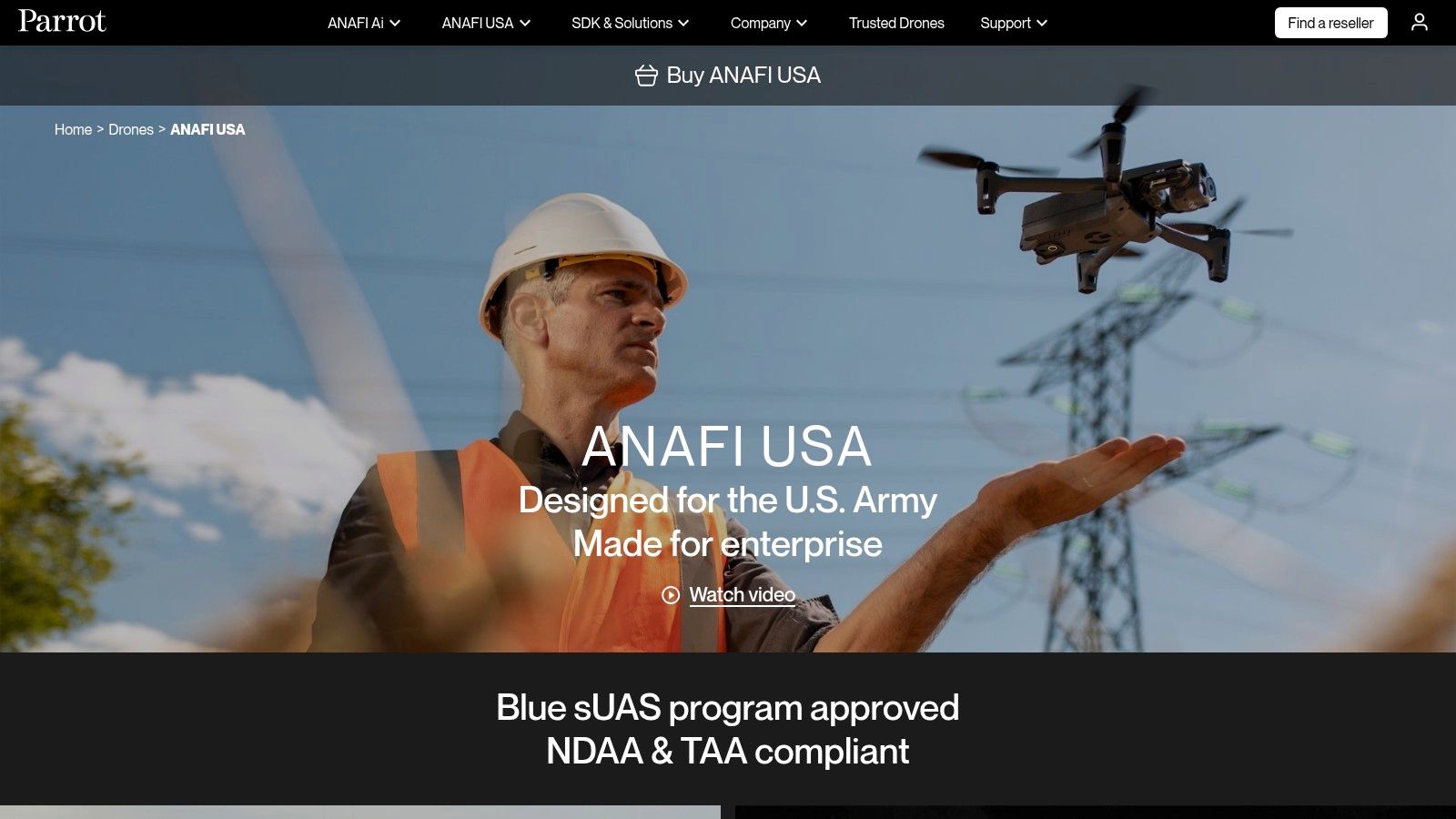
The ANAFI USA boasts a remarkable 32x zoom capability coupled with a 4K HDR camera, enabling crystal-clear close-up inspections from a safe distance. Its integrated FLIR Boson thermal imaging sensor adds another layer of utility, allowing operators to detect heat signatures for applications like search and rescue, firefighting, and asset monitoring. Weighing only 500g, the ANAFI USA is remarkably portable, making it easy to deploy in diverse environments. Despite its compact size, it offers a respectable 32-minute flight time, providing ample time for data acquisition. Furthermore, data security is a core design principle of the ANAFI USA. It features encrypted communications and secure firmware updates, ensuring data integrity and minimizing vulnerabilities. This focus on data security makes it particularly attractive to government agencies and organizations handling sensitive information.
While pricing can vary, the ANAFI USA typically falls in the mid-range price bracket for professional drones, offering significant value for its specialized capabilities. Technical requirements are minimal, primarily involving a compatible mobile device running the FreeFlight 6 app for control and data visualization. Compared to larger commercial drones like the DJI Matrice series, the ANAFI USA offers superior portability and data security, although it compromises on payload capacity and flight time. Its smaller size also makes it less stable in high winds.
For implementation, ensure you familiarize yourself with the FreeFlight 6 app and practice flying in a controlled environment. Calibrating the compass and IMU before each flight is crucial for optimal performance. When utilizing the thermal imaging capabilities, consider environmental factors like ambient temperature and humidity, which can affect accuracy. The ANAFI USA's lightweight design makes it ideal for rapid deployment, particularly in scenarios where discreet operation is necessary. Its encrypted data transmission provides an additional layer of security, assuring users that sensitive information remains protected. The drone's "Made in USA" pedigree and compliance with U.S. government security requirements further solidifies its position as a trustworthy tool for sensitive commercial and governmental applications.
Pros:
Strong focus on data security and sovereignty
Extremely portable design
Excellent thermal capabilities for its class
Meets U.S. government security requirements
Cons:
Limited payload options compared to larger platforms
Shorter flight time than larger commercial drones
Less robust in high wind conditions due to light weight
8. FreeFly Astro
The FreeFly Astro stands out as a premier choice among drones in commercial use, specifically designed for demanding applications like professional cinematography and heavy-duty industrial tasks. Its robust carbon fiber frame and open payload architecture allow it to carry substantial payloads of up to 3kg, accommodating cinema-grade cameras, LiDAR scanners, and other specialized equipment. This makes it a versatile tool for diverse sectors, from film production and precision agriculture to infrastructure inspection and surveying. With a flight time of approximately 30 minutes under ideal conditions, the Astro provides ample time for complex operations. Further enhancing its professional capabilities, the Astro incorporates advanced flight control systems, guaranteeing stability and precision even in challenging environments.
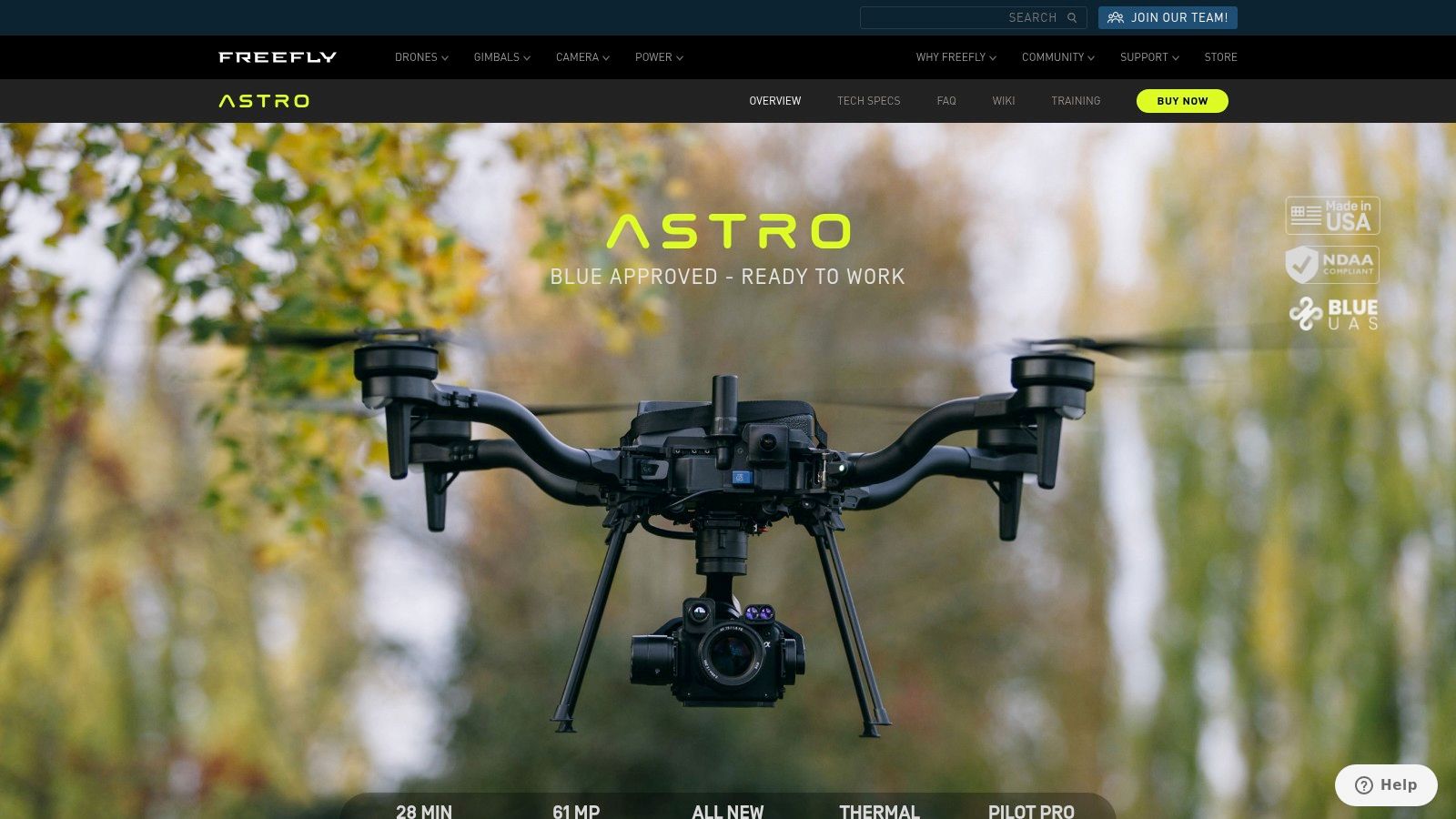
A key differentiator of the FreeFly Astro is its modular design, enabling extensive customization. This open architecture makes it particularly appealing for industrial applications requiring specific sensor integration or unique payload configurations. For example, in infrastructure inspection, the Astro can be equipped with high-resolution cameras and thermal sensors to detect structural weaknesses in bridges or power lines. In precision agriculture, it can carry multispectral cameras to analyze crop health and optimize irrigation strategies. The "Made in the USA" commitment further strengthens its appeal, ensuring accessibility to parts and support for streamlined maintenance and repairs. Compared to prosumer drones, the Astro offers a significant leap in performance and adaptability, albeit at a premium.
Features:
Heavy-lift capability (up to 3kg payload)
Open payload architecture for custom integrations
Carbon fiber construction for durability and lightweight performance
Advanced flight control system for enhanced stability
Made in the USA with serviceability in mind
Pros:
Exceptional build quality and reliability
Highly customizable for specialized applications
Superior stability, ideal for professional cinematography
Domestic manufacturing and readily available support
Cons:
Premium pricing (approximately $15,000+ depending on configuration)
Steeper learning curve than consumer/prosumer models
Requires specialized knowledge for complex custom integrations
Implementation/Setup Tips:
Due to its complexity, plan for thorough training on the Astro's flight systems and payload integration before undertaking commercial operations.
Consider consulting with FreeFly Systems or authorized dealers for customized payload configurations and integration assistance.
Factor in the cost of additional accessories like batteries, specialized payloads, and transportation cases when budgeting for the Astro.
The FreeFly Astro’s robust features and focus on customizability make it a valuable asset for professionals seeking a high-performance, reliable platform for complex commercial drone applications. Its premium price point reflects its exceptional build quality, advanced features, and the support network provided by FreeFly Systems. While it might require a more significant investment and a steeper learning curve, the Astro provides a powerful solution for those needing the best in terms of payload capacity, stability, and adaptability for their drones in commercial use. For more information, visit the official website: https://freeflysystems.com/astro
Commercial Drone Models Feature Comparison
Application | 🔄 Implementation Complexity | ⚡ Resource Requirements | 📊 Expected Outcomes | 💡 Ideal Use Cases | ⭐ Key Advantages |
|---|---|---|---|---|---|
DJI Mavic 3 Enterprise | Moderate to High - advanced features and licensing | High - professional-grade drone with RTK modules | High-quality imaging, precise positioning | Inspection, mapping, public safety | Exceptional image quality, extended flight time |
Skydio X10 | High - specialized AI software ecosystem | High - autonomous navigation & security features | Reliable autonomous flight and obstacle avoidance | Infrastructure inspection, law enforcement | Industry-leading autonomy and obstacle avoidance |
Autel EVO II Enterprise | Moderate - modular but less mature software | Moderate - multiple configs and 40 min flight | Detailed inspections with thermal imaging | Security-conscious orgs, detailed inspections | Modular design, good value alternative |
DJI Matrice 300 RTK | Very High - complex payloads and operations | Very High - large drone with multi-payload support | Long missions with versatile sensor payloads | Industrial inspections, surveying, harsh conditions | Long flight time, durability, payload versatility |
Wingtra One | Moderate - VTOL with automated mission planning | High - fixed-wing drone with PPK/RTK | Large area coverage with survey-grade accuracy | Large-scale mapping, mining, agriculture | Extensive area coverage, high-precision mapping |
senseFly eBee X | Moderate - fixed-wing, automated but less versatile | Moderate - lightweight with long flight time | Very large coverage, precision agriculture | Precision agriculture, environmental monitoring | Exceptional endurance, regulatory advantages |
Parrot ANAFI USA | Low to Moderate - compact design with security focus | Low - lightweight and portable | Secure data collection with thermal imaging | Public safety, security, inspection | Strong data security, portability |
FreeFly Astro | High - advanced customization and payload integration | High - heavy-lift with advanced controls | Stable flight for cinematography and industry | Film production, custom industrial applications | High build quality, modularity, stability |
Choosing the Right Drone for Your Commercial Needs
From compact, versatile platforms like the DJI Mavic 3 Enterprise and Autel EVO II Enterprise to specialized heavy-lifters like the DJI Matrice 300 RTK and Wingtra One, the range of drones in commercial use today is truly remarkable. We've explored eight leading models, each with its own strengths and ideal applications. Key takeaways include the importance of considering factors such as flight time, payload capacity, and integrated sensors when making your decision. While the DJI Mavic 3 Enterprise excels in various commercial applications, it's worth noting the increasing specialization of drones within specific industries. For instance, the rise of precision agriculture has led to the development of advanced drones tailored for farming tasks. You can learn more about these specialized platforms in this helpful resource on agriculture drones. Additionally, remember to factor in software integration capabilities and the overall ecosystem surrounding each drone platform.
Selecting the optimal drone for your commercial operation hinges on a clear understanding of your specific needs and budget. Begin by defining your primary use cases: aerial photography, surveying, inspections, delivery, or other specialized tasks. Next, prioritize essential features: high-resolution cameras, thermal imaging, LiDAR sensors, obstacle avoidance systems, and extended flight times. Finally, consider ease of use, maintenance requirements, and the availability of technical support.
The future of commercial drone operations is bright, with constant innovation pushing the boundaries of what's possible. By carefully evaluating your requirements and staying informed about the latest advancements in drone technology, you can harness the power of these incredible tools to enhance your business operations. Ready to take your commercial drone operations to the next level? JAB Drone offers comprehensive resources and tools to help you find, compare, and select the perfect drone for your specific needs. Explore the latest drones in commercial use and optimize your aerial workflow by visiting JAB Drone today.




Comments